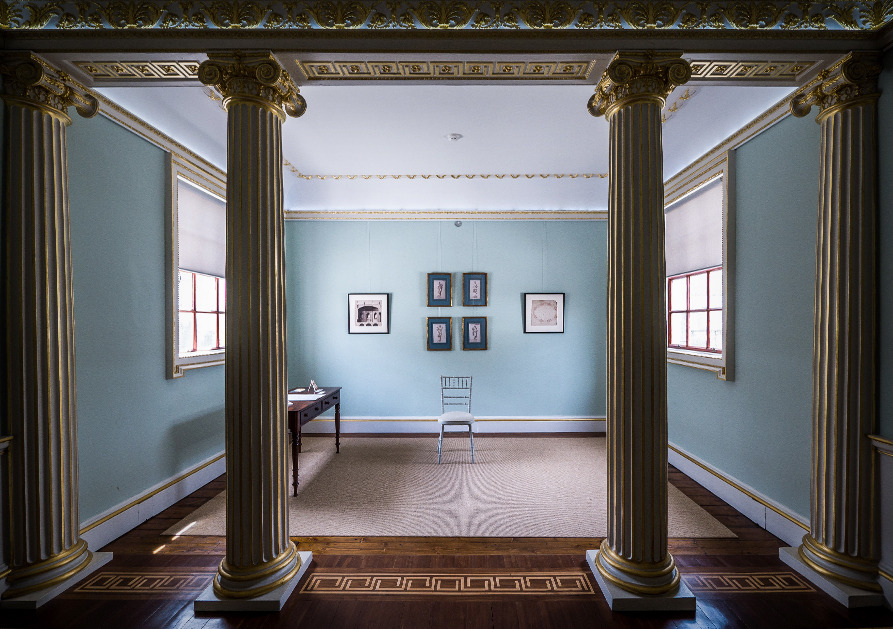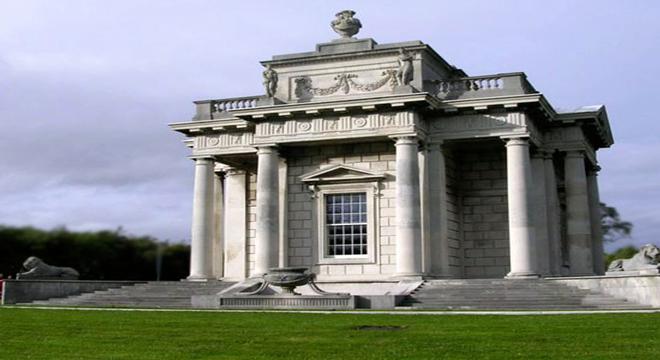Casino At Marino Interior
1773 – Casino, Marino, Dublin Architect: Sir William Chambers Acknowledged as the most important neo-classical building in Ireland, the Casino was designed by Sir William Chambers for Lord Charlemont as a garden pavilion at his Marino Estate. The Casino was built by Sir William Chambers in 1769 in the grounds of the first Earl of Charlemont's villa of Marino at Clontarf on the outskirts of Dublin. Chambers had built the Earl's town house in Dublin in 1763. William Ashford was born at Birmingham but worked a great deal in Ireland, where. The Casino is located at Marino, just off the Malahide Road and only three miles north of the centre of Dublin. Location: 5km north of City Centre, off the Malahide Road, after junction with Griffith Avenue (turn left at pedestrian lights after Dublin Fire Brigade Training H.Q.).
Widely acknowledged as the best neo-classical Georgian building in Ireland, this was built in the second part of the 18th century as a ‘folly’. a garden pavilion for James Caulfield, the 1st Earl of Charlemont.
It was designed by by Sir William Chambers, who was also architect for the Examination Hall and Chapel at Trinity College and Charlemont House, which now houses the Hugh Lane Gallery.
As a young adult Lord Charlemont spent more than 9 years on a ‘Grand Tour’ of Europe, where during visits to Italy and Greece he developed a love for classical architecture.
Featured image by MaestroBen
Plans for the Casino, courtesy Old Irish Maps
He met with Chambers on his travels and they became good friends, so when he came up with the notion of creating his own architectural gem it was to him he turned.
The original house is long gone, but both the Casino and the remaining portions of the garden which surround it give some idea of the grandeur that once existed here.
At one time the Casino would have been the focal point of a long view down the park from the reception rooms of the original Marino House.
It was used as a summer house and occasional guest house, but its main purpose was simply to look good!
The Casino Building
Although very imposing looking, the building is quite small, just 50ft square, with enormous windows and doors which give the impression that there is just a single room inside. In fact there are a surprising number of rooms, arranged on three levels.

The exterior is highly decorated, with urns, carvings, statues and pillars. Inside it is no less elaborate, with fine Georgian mouldings and plasterwork, inlaid floors and elegant mantelpieces and doors.
There are some wonderful little hidden details, designed to preserve the decorative look of the building while ensuring it was functional.
For example the urns on the rooftop are actually chimneys and some of the pillars are hollow and act as down pipes, draining water from the roof. An underground tunnel once gave access to the Casino from the main house, but this is now blocked.
The Charlemont estate, along with the original contents of the Casino, was sold in 1881 and the land began to be developed and built on, and the Casino fell into disrepair. It was in very poor condition when taken into state care in the 1930’s but has now been carefully and very well restored to its original condition.
David Linley, the renowned British designer, created a marvelously intricate ‘Casino at Marino’ jewellry box, complete with secret compartments and catches, made from sycamore. It is a one off piece, not available to buy, but worth taking a look at for its exquisite craftsmanship.
How the Casino Marino Got its Name
The Casino is not now and never was a gambling den of any kind, but in spite of this I recently saw it described on another website as “the best known casino is Dublin presenting a diversity of gaming options, including slots and video poker machines” – you really don’t want to believe everything you read online!
The name is sometimes believed to come from the Italian word ‘Casina’ meaning ‘small house’ and ‘Marino’ meaning ‘small sea’, but in fact has the same root as more modern casinos coming from the Italian for ‘house of fun’. It must confuse Italian visitors to Ireland somewhat, since in Italy the word is used nowadays for a brothel!
Hat tip to Colm Kenny (see comments below) for that information.
The neighbouring suburb of Marino, which began to develop in the 1920’s on what was once the Charlemont estate, takes its name from the house that once stood here – Marino House.
Recent Planning Controversy
The Casino is currently embroiled in something of a controversy. Dublin County Council has lodged a planning application in early 2007, proposing the construction of a medico-legal centre in its grounds, a facility which would include the offices of the State Pathologist.
This proposal is strenuously opposed by the Irish Georgian Society. The Department of the Environment, who are responsible for the care of the building, have also expressed concern.
Visiting the Casino
The Casino is about 5km from the city centre and is convenient to several bus routes and a few minutes walk from Clontarf Road Dart Station. It is open daily from May to October, weekends only from November to April.
Entrance is free to holders of either a Dublin Pass or a Heritage Card
Widely acknowledged as the best neo-classical Georgian building in Ireland, this was built in the second part of the 18th century as a ‘folly’. a garden pavilion for James Caulfield, the 1st Earl of Charlemont.
It was designed by by Sir William Chambers, who was also architect for the Examination Hall and Chapel at Trinity College and Charlemont House, which now houses the Hugh Lane Gallery.
Casino At Marino Interior Map
As a young adult Lord Charlemont spent more than 9 years on a ‘Grand Tour’ of Europe, where during visits to Italy and Greece he developed a love for classical architecture.
Featured image by MaestroBen
Plans for the Casino, courtesy Old Irish Maps
He met with Chambers on his travels and they became good friends, so when he came up with the notion of creating his own architectural gem it was to him he turned.
The original house is long gone, but both the Casino and the remaining portions of the garden which surround it give some idea of the grandeur that once existed here.
At one time the Casino would have been the focal point of a long view down the park from the reception rooms of the original Marino House.
It was used as a summer house and occasional guest house, but its main purpose was simply to look good!
The Casino Building
Although very imposing looking, the building is quite small, just 50ft square, with enormous windows and doors which give the impression that there is just a single room inside. In fact there are a surprising number of rooms, arranged on three levels.
The exterior is highly decorated, with urns, carvings, statues and pillars. Inside it is no less elaborate, with fine Georgian mouldings and plasterwork, inlaid floors and elegant mantelpieces and doors.

Casino At Marino Interior Photos
There are some wonderful little hidden details, designed to preserve the decorative look of the building while ensuring it was functional.
For example the urns on the rooftop are actually chimneys and some of the pillars are hollow and act as down pipes, draining water from the roof. An underground tunnel once gave access to the Casino from the main house, but this is now blocked.
The Charlemont estate, along with the original contents of the Casino, was sold in 1881 and the land began to be developed and built on, and the Casino fell into disrepair. It was in very poor condition when taken into state care in the 1930’s but has now been carefully and very well restored to its original condition.
David Linley, the renowned British designer, created a marvelously intricate ‘Casino at Marino’ jewellry box, complete with secret compartments and catches, made from sycamore. It is a one off piece, not available to buy, but worth taking a look at for its exquisite craftsmanship.
How the Casino Marino Got its Name
The Casino is not now and never was a gambling den of any kind, but in spite of this I recently saw it described on another website as “the best known casino is Dublin presenting a diversity of gaming options, including slots and video poker machines” – you really don’t want to believe everything you read online!
The name is sometimes believed to come from the Italian word ‘Casina’ meaning ‘small house’ and ‘Marino’ meaning ‘small sea’, but in fact has the same root as more modern casinos coming from the Italian for ‘house of fun’. It must confuse Italian visitors to Ireland somewhat, since in Italy the word is used nowadays for a brothel!
Hat tip to Colm Kenny (see comments below) for that information.
The neighbouring suburb of Marino, which began to develop in the 1920’s on what was once the Charlemont estate, takes its name from the house that once stood here – Marino House.
Recent Planning Controversy
The Casino is currently embroiled in something of a controversy. Dublin County Council has lodged a planning application in early 2007, proposing the construction of a medico-legal centre in its grounds, a facility which would include the offices of the State Pathologist.
This proposal is strenuously opposed by the Irish Georgian Society. The Department of the Environment, who are responsible for the care of the building, have also expressed concern.
Visiting the Casino
The Casino is about 5km from the city centre and is convenient to several bus routes and a few minutes walk from Clontarf Road Dart Station. It is open daily from May to October, weekends only from November to April.
Entrance is free to holders of either a Dublin Pass or a Heritage Card